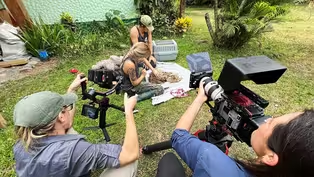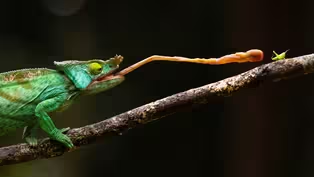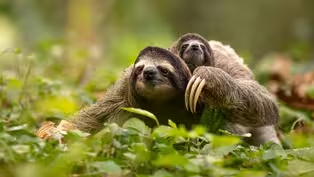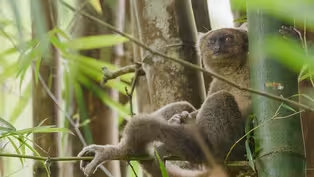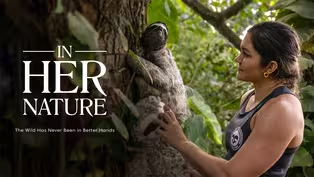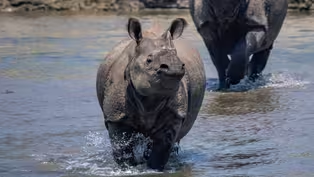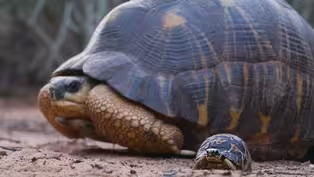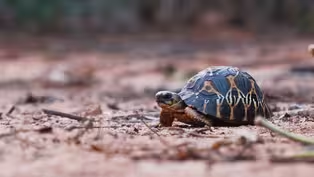
The Slowest Stampede on Earth | In Her Nature
Special | 19m 31sVideo has Closed Captions
In the otherworldly Spiny Forest of Madagascar, a historic release is about to take place.
In the otherworldly Spiny Forest of Madagascar, a historic release is about to take place. After 15 years of dedicated care and community teamwork, a trio of female herpetologists is reintroducing a “stampede” of 1,000 critically endangered radiated tortoises.
Problems playing video? | Closed Captioning Feedback
Problems playing video? | Closed Captioning Feedback
Major support for NATURE is provided by The Arnhold Family in memory of Henry and Clarisse Arnhold, Sue and Edgar Wachenheim III, The Fairweather Foundation, Charles Rosenblum, Kathy Chiao and...

The Slowest Stampede on Earth | In Her Nature
Special | 19m 31sVideo has Closed Captions
In the otherworldly Spiny Forest of Madagascar, a historic release is about to take place. After 15 years of dedicated care and community teamwork, a trio of female herpetologists is reintroducing a “stampede” of 1,000 critically endangered radiated tortoises.
Problems playing video? | Closed Captioning Feedback
How to Watch Nature
Nature is available to stream on pbs.org and the free PBS App, available on iPhone, Apple TV, Android TV, Android smartphones, Amazon Fire TV, Amazon Fire Tablet, Roku, Samsung Smart TV, and Vizio.
Buy Now
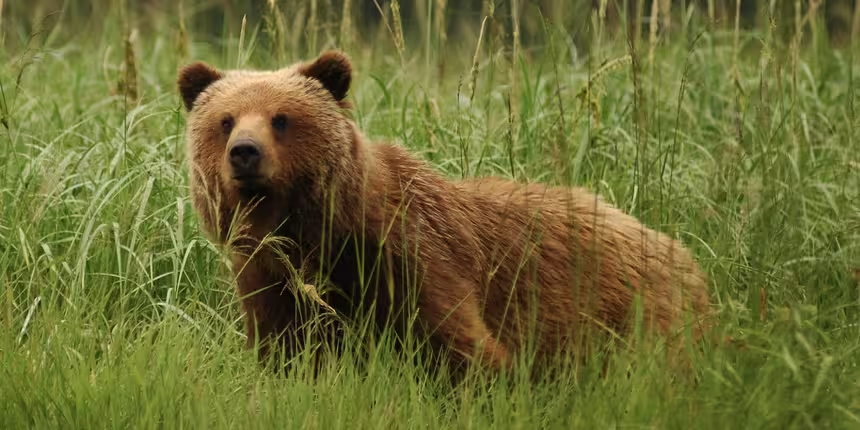
Explore More Ways to Watch
Bring the beauty and wonders of wildlife and natural history into your home with classic NATURE episodes.Providing Support for PBS.org
Learn Moreabout PBS online sponsorshipMore from This Collection
"In Her Nature" shines a spotlight on the fearless women who protect the wildlife of our world. Featuring breathtaking cinematography combined with rare animal behavior, "In Her Nature" showcases the robust conservation efforts being led by women in the most perilous habitats through the lens of an award-winning, all-female production team.
The Women Behind the Wild | In Her Nature
Video has Closed Captions
Go behind the lens with the making of 'In Her Nature.' (30m 40s)
The Chameleon Queen | In Her Nature
Video has Closed Captions
Despite cultural taboos, herpetologist Fandresena Rakotoharimalala is determined to save chameleons. (13m 25s)
Saving The Slowest Mammal on Earth | In Her Nature
Video has Closed Captions
A sloth scientist, her tree-climbing BFF, and their dog work to save Costa Rica’s sloth populations. (37m 46s)
Saving the World’s Rarest Lemurs | In Her Nature
Video has Closed Captions
Greater bamboo lemurs, recently thought to be extinct, are critically endangered. (22m 1s)
Series Trailer | In Her Nature
Video has Closed Captions
Meet the courageous women shaping wildlife conservation. (1m 25s)
The Rhino Whisperer | In Her Nature
Video has Closed Captions
The story of Nepal's first female nature guide and her fight to save the country's wildlife. (20m 51s)
Providing Support for PBS.org
Learn Moreabout PBS online sponsorshipFrequency?
One hundred and fifty point nine hundred and seventy eight Finding the right time and place to release a thousand tortoises at the same time, is not easy.
Temperature?
Twenty-three point zero six.
They are too cold.
There is no other nature quite like here in Madagascar.
The Ala Maiky spiny forest can be found in the south part of our Island.
This is a unique forest due to the lack of rain It's also unique because of the spines we have here, which is a survival mode for retaining water when it rains.
Sometimes, it has not rained in this region for 3 years We also have a belief in this region saying that a thirsty tortoise looking at the sky means that the rain is coming.
They are called radiated tortoises Because their shells are like rays of sunlight, colored yellow with black patterns and they shine like the sun.
In the world record book, the oldest tortoise reached 170 years old.
So tortoises live a long time.
Tortoises have remarkable adaptation and resilience.
They eat different kinds of food, but in the last centuries, cactus became their staple food.
These plants are not originally from Madagascar.
Without the tortoises, invasive plants like cactus will grow very quickly.
The species native to the region would disappear.
Cactus would completely cover the forests of Madagascar.
The number of radiated tortoises has decreased 40% within the last fifty years.
Radiated tortoises face the threats of theft and illegal sale at national and international level.
My children always talk about how their mom saves sick and endangered tortoises.
There are few women working with tortoises.
Even fewer pregnant.
My daughter will arrive in 2 months, and I can't wait to show her this incredible forest.
TSA Madagascar represents the future for the protection of the tortoises.
We take in tortoises that have been stolen or poached.
We take in tortoises that have been stolen or poached.
We bathe them and monitor their health.
When we see that they are in good health, we put them in enclosures Once all that is done, we carry out the reintroduction.
Protecting them motivates me to do this work, Because I want to do my part to help protect Madagascar's endemic species.
The communities living in the area collaborate with us and protect the tortoises.
For the Antandroy tribe, it is forbidden to steal, eat or kill the tortoises.
They know the importance of the protection of the tortoises.
They think that feeding a tortoise you meet with a green plant will bring luck.
We can't do our work without the help of the communities.
We need 12 tons of food every month.
90% are supplied by the community.
To feed them, we buy their food from the local community, Today we're gonna buy cactus to feed the tortoises.
We will buy about 1,000 kg of food today.
Let's begin the weighing.
Twenty.
Koloina is leading a team composed of ten men.
She is the only woman in the group.
Women are not valued enough in this region, but she still had the courage to work here.
I love my job but of course, I face challenges.
The custom in this region is to not give any responsibilities to women.
So it's strange for them to see a woman as a manager.
But when you love your job, you can do it.
Position it a little lower.
How many kilograms is it?
Twenty-nine.
This one is too heavy.
our ID card, please?
We are all done counting.
We've paid the local community and now, we are going to transport the tortoise's food.
Once inside the enclosure, we start to prepare the food.
we cut the food into pieces according to the size of the tortoise.
and take into account whether they are adults or juveniles.
I like tortoises because they are calm.
I want to learn how to be calm like them.
I consider them as my friends because I can talk to them and they can understand me.
Hey.
Where are you going?
Don't you want to eat today?
Your favorite food is all ready.
Each tortoise has different patterns on their shells.
It's like their fingerprint.
So we take photos of each shell that we enter in a database.
This is their personal identity So if one goes missing we can use the pictures of their shells as a reference to find them.
We are collaborating with other institutions now to create software aimed to identify tortoises species through the pattern of their shells.
In the long term, the database will help to track confiscated ones and to get exact information about them.
We have seventy village volunteers working with us now.
They report any attempted offences or thefts of tortoises in the forest.
Thanks to this, we have been able to stop several attempts of stealing tortoises.
Okay I have to go now.
But I hope when I come back, you will be all grown up.
For tortoises it takes a long time to reach the size that they will be able to be released back to the wild again.
Sometimes we need up to 15 years.
15 years is a long time to wait...
...But it is the safest size for them to be on their own again.
But as of this coming Thursday, We are going to reintroduce A thousand tortoises back into their natural habitat.
My name is Andriantenaina Mitia.
I am helping Doctor Tsanta.
I am in charge of the technical side, which means, I manage the samples and the health analysis.
For the health assessment, we do a biochemical blood analysis.
We have to make sure that the tortoises we release won't bring diseases to other tortoises in the area.
the tortoises are usually released when they are between 17.5 cm to 25 cm, and they become "sub-adults".
If they arrive at our center when they are too small, we might wait up to 15 years before their release.
This is the first release that I will be part of and I'm really excited and happy for this opportunity Everything looks really good.
We have a really healthy tortoise that is able to go back to the wild!
Would you mind to verify first that the radio is working?
Yes, it's on.
Time?
For the monitoring, we equip the tortoises with radio transmitters in order to locate them with the antenna.
It helps us with our monitoring work by telling us where they've been, how many kilometers they've traveled, what time of day are they more active?
Before it dries, we put some soil on it for camouflage.
We put the GPS data logger here to make it comfortable for the tortoise.
Pull it tight.
The aim is to achieve zero lost tortoises, so we don't have to reintroduce any more.
Everyone on the team is happy.
We say that it's like your children are getting married.
I am excited to see them on their own.
I'm really excited.
Tsanta and the team have worked so hard for this release.
I think she's hoping for the release to go smoothly.
We make sure to keep the tortoises well hydrated Before we release them in one of the driest places on Earth.
These ones will be released first.
We have a famous saying, "Tortoises are not in a hurry but they always reach their final destination."
Go back to your home sweet home.
She is going to back into her natural home.
And hope she will survive and produce offspring.
Be free.
Bye bye, we will see you soon.
Since the reintroduction of the tortoises, We've had no case of theft.
We use telemetry to check on the health of the tortoises every two weeks.
One tortoise traveled over 40 km.
I'm so happy the tortoises we have released are in good health.
Field work is not easy.
But being a woman is not a barrier Don't think that as a woman, it's impossible for you to venture far away.
These are baby radiated tortoises They just hatched recently.
We will make sure that they grow up and and they can be back to the wild again once they are strong enough.
They are the future.
We choose to release them at this size Because it is easy for traffickers to steal, hide and put small tortoises in a bag.
We're excited to release them into the wild because this is why we take care of them for so long.
Growing Up as a Radiated Tortoise
Video has Closed Captions
Clip: Special | 48s | It takes 15 years of care before a baby Radiated Tortoise is ready for life in the wild. (48s)
No Two Radiated Tortoises Are Alike
Video has Closed Captions
Clip: Special | 1m 16s | No two Radiated Tortoises are alike—each shell tells its own story. (1m 16s)
Providing Support for PBS.org
Learn Moreabout PBS online sponsorship
- Science and Nature

Explore scientific discoveries on television's most acclaimed science documentary series.













Support for PBS provided by:
Major support for NATURE is provided by The Arnhold Family in memory of Henry and Clarisse Arnhold, Sue and Edgar Wachenheim III, The Fairweather Foundation, Charles Rosenblum, Kathy Chiao and...
